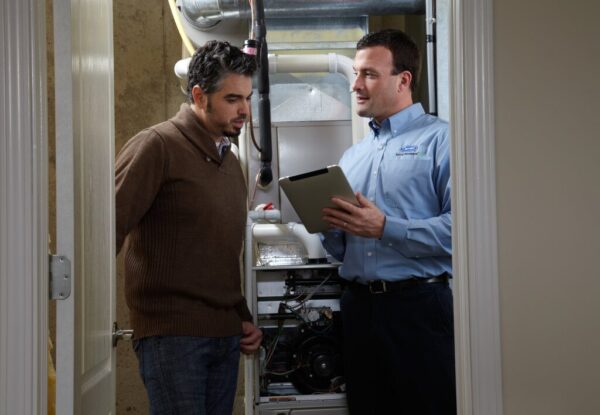
With winter quickly rounding the corner, it’s time to start thinking about how to prepare your furnace before the cold weather settles in. Use these 12 tips to ensure that your furnace is ready to see you through the entire winter while protecting your wallet.
1. Change or Clean Your Air Filter
Start by changing or cleaning your air filter. If you have a central HVAC system, to get it ready for winter, you’ll need to change the disposable filter before the cold air comes along. Plan to check the filter every 30 days so you can change it before it clogs, and expect to change it every 30 to 90 days if you have the common 1- and 2-inch filter.
If you have a ductless mini-split system, clean the filter in each air handler. You should plan to clean these about every 2 weeks, ensuring they are completely dry before reinstalling them.
2. Get Annual Furnace Maintenance
Annual furnace maintenance is critical for your furnace to keep it running efficiently and protect your unit’s factory warranty. The work they’ll perform will reduce both the strain on the system and the energy consumed to heat your home. You’ll experience better comfort and extend your system’s service life.
3. Consider Replacing Your Thermostat
Most digital thermostats have an expected service life of 10 to 15 years. As the thermostat ages into this range, it may not register temperature as accurately as it did when it was newer. This may cause your system to run longer heating cycles or fail to start when it needs to.
If your thermostat is older than 10 years old, consider replacing it with a newer programmable model. You may also consider upgrading to a smart thermostat that can help you set your system’s programs and give you remote access while you’re away.
5. Look For a Pilot Light
If your system uses a standing pilot light, check to make sure that it’s still burning. Look for a label on the side of your furnace with lighting instructions to determine if you have a standing pilot light, or check the owner’s manual.
If you have a pilot light, your furnace likely has a small window toward the bottom of the unit that should allow you to see if it’s burning. If you can’t see it, you’ll want to light it before trying to start the furnace for the first time in the season.
6. Test Your Smoke and Carbon Monoxide Detectors
Furnaces come with inherent risks since you are burning combustible fuel. While those risks are low when you properly maintain your system, you want to make sure you’re ready to catch possible problems.
One obvious problem is a fire starting at the furnace. Your smoke detector will help alert you in case the furnace doesn’t control the fire properly. However, a more significant danger is the carbon monoxide produced by the burning fuel. If you have a cracked heat exchanger, this toxic gas will leak out into your home. Check to make sure both your smoke and carbon monoxide detectors have good batteries and are passing operational tests.
7. Do a Test Run in the Fall
It’s always a good idea to test something before you’re in a position to depend on it for your safety and comfort. Your furnace is no different.
As the temperature starts cooling down, plan to do a test run to ensure that it fires up correctly. When you have time to watch the entire process, flip your thermostat to heat, and then observe your furnace for an entire cycle. You want to keep your eyes, ears and nose open for:
- Unusual sounds as it cycles
- Burning smells that don’t dissipate
- Smell of gas
- Rattling sounds as it starts up
- Failure to produce heat
- Failure to start at all
If you notice any of these issues, turn off your furnace and call for a professional technician to troubleshoot the issue. Many of these can indicate significant problems that could be hazardous for your home.
8. Check Your Fuel Level
If your home is in an area where you don’t have natural gas service, you’ll want to check the level of your fuel. You can obviously just call to have your fuel tank refilled so that you’re set to start the winter.
If you want to know how much fuel you have in your tank, get some warm water and pour it over the tank. Run your hand down the side and notice where the tank becomes cooler as you go down. The point at which it becomes cool is the level of propane in the tank.
9. Check Your Furnace Chimney
If you have a standard-efficiency furnace, you’ll have an exhaust chimney that goes through your roof. This is usually a metal tube with a cage at the top of it. Before lighting your furnace for the first time, make sure the exhaust chimney is clear of obstructions. They can become clogged with animal nests, leaves and so much more. While inspecting it, check how much soot is in the chimney, and find out if you should have it cleaned.
If you have a high-efficiency furnace, you may have an exhaust pipe that comes through the side of your home. This happens because the exhaust is no longer hot enough to come out to pose a risk. Find where it comes out, and ensure that it isn’t clogged.
10. Reset Your Thermostat Programs
As you get ready to set your furnace for the season, you’ll want to adjust the settings on your thermostat’s programs. First, check that the time is set correctly. Next, adjust the time and temperature for your programs to reflect your winter schedule and that you’ll be running heat. The temperature recommended by the Department of Energy is 68 degrees when you’re home and awake.
11. Open and Clear All Supply Vents
Without open and clear vents, your system won’t be able to effectively heat your home. Take a few minutes to check that all of your vents are open. While checking them, ensure that each one has at least 6 inches around it and above it to allow the warm air to flow without restriction.
12. Get Minor Problems Fixed
It’s easy to justify ignoring small problems with your furnace. Sure, you may have that unusual sound, but it’s still heating your home, so you may not feel any urgency to get it resolved.
Before setting your furnace for the winter, get those small problems fixed. When you have small issues, it causes strain across your entire system. This added strain increases the amount of energy your furnace consumes, driving up your operating costs. Further, it adds wear to other components in the system, leading to more extensive repairs and increasing the risk of a mid-season breakdown.
Property owners around San Antonio trust Beyer Air Conditioning & Heating when they need help keeping their homes comfortable. Our team provides AC and furnace maintenance, repair and installation together with duct cleaning and repair and indoor air quality solutions. Call to schedule your pre-season furnace maintenance with one of our experienced technicians today.



